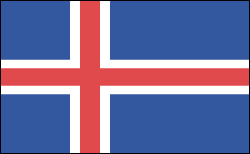GeographyIceland, an island about the size of Kentucky, lies in the north Atlantic Ocean east of Greenland and just touches the Arctic Circle. It is one of the most volcanic regions in the world. More than 13% is covered by snowfields and glaciers, and most of the people live in the 7% of the island that is made up of fertile coastland. The Gulf Stream keeps Iceland's climate milder than one would expect from an island near the Arctic Circle. GovernmentConstitutional republic. HistoryThe earliest inhabitants of Iceland were Irish hermits, who left the island upon the arrival of the pagan Norse people in the late 9th century. A constitution drawn up c. 930 created a form of democracy and provided for an Althing, the world's oldest practicing legislative assembly. The island's early history was preserved in the Icelandic sagas of the 13th century. In 1262–1264, Iceland came under Norwegian rule and passed to ultimate Danish control through the unification of the kingdoms of Norway, Sweden, and Denmark (the Kalmar Union) in 1397. In 1874, Icelanders obtained their own constitution, and in 1918, Denmark recognized Iceland, via the Act of Union, as a separate state with unlimited sovereignty. It remained, however, nominally under the Danish monarchy. During the German occupation of Denmark in World War II, British, then American, troops occupied Iceland and used it for a strategic air base. While officially neutral, Iceland cooperated with the Allies throughout the conflict. On June 17, 1944, after a popular referendum, the Althing proclaimed Iceland an independent republic. Iceland Elects the World's First Female Chief of StateThe country joined the North Atlantic Treaty Organization in 1949 and subsequently received an American air force base in 1951. In 1970, it was admitted to the European Free Trade Association. Iceland unilaterally extended its territorial fishing limit from 3 to 200 nautical miles in 1972, precipitating a dispute with the UK known as the “cod wars,” which ended in 1976 when the UK recognized the new limits. In 1980, the Icelanders elected a woman to the office of the presidency, the first elected female chief of state (i.e., president as distinct from prime minister) in the world. After the recession of the early 1990s, Iceland's economy rebounded. At the International Whaling Commission meeting in July 2001, Iceland refused to agree to the continuation of the moratorium on commercial whaling that had been in effect since 1986. In 2003, after a 14-year lull, the country began hunting whales for scientific research. In May 2003, David Oddsson was reelected, making him the longest-serving prime minister in Europe. In 2004, in a prearranged agreement made between the two parties of the coalition government, Oddsson and Foreign Minister Halldór Ásgrímsson switched positions. In June 2006 Ásgrímsson resigned as prime minister after his party did badly in local elections. Economic troubles were cited as the main reason for the Progressive Party's poor showing. Geir Haarde, leader of Iceland's largest political party, the Independence Party, became prime minister and announced the implementation of more fiscally conservative measures. On October 9, 2008, amidst international stock market turmoil, the Icelandic stock exchange suspended trading and the government decided to nationalize three major banks. In November 2008, the IMF extended a $2 billion rescue package to Iceland to help its battered currency and stock market. Despite the aid, the financial crisis continued into 2009, prompting demonstrations against the government. Prime Minister Geir Haarde resigned on January 26, 2009, causing the collapse of Iceland's government. On February 1, 2009, Johanna Sigurdardottir was sworn in as the new prime minister, becoming Iceland's first female prime minister and the modern world's first openly gay head of government. | ||||
Iceland
The Republic of Iceland was established 17 June, 1944. Learn more about the history and geography of this country.






